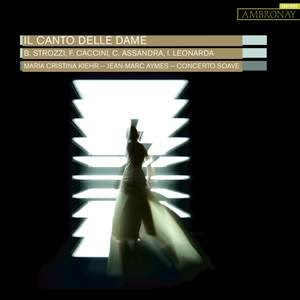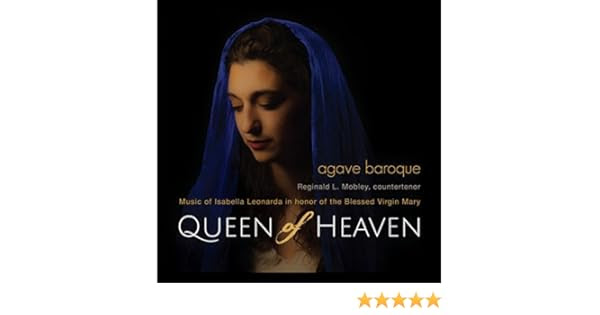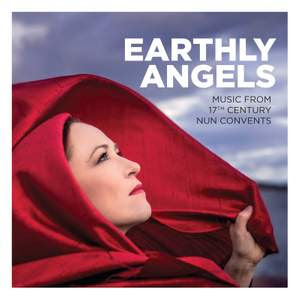Program: #20-22 Air Date: May 18, 2020
To listen to this show, you must first LOG IN. If you have already logged in, but you are still seeing this message, please SUBSCRIBE or UPGRADE your subscriber level today.
Sacred works from convents and courts by women composers in the 17th century.
I. Il Canto delle Dame (Maria Cristina Kiehr, s./Concerto Soave/Jean-Marc Aymes). Ambronay CD AMY025.

The genesis of Concerto Soave is closely bound up with the music of 17th -century Italian composers. Thus the ensemble was the first, some 15 years ago, to devote a recording to the Sacri Musicali Affetti of Barbara Strozzi (for empreinte digitale). However, the great Venetian woman composer is not the only one who deserves the honour of recording.
Most of these ladies came from the ranks of the aristocracy; some consecrated themselves to God. In both cases, they found the wherewithal not only to compose and to achieve recognition from their peers, but also to publish their output.
María Cristina Kiehr has established a reputation with press and public alike as one of the leading interpreters of baroque vocal music. She is capable of combining the smoothness of her unique timbre with fervent respect for the poetic texts she champions with humility and warmth. Trained by René Jacobs at the schola Cantorum in Basel, she taken part in a large number of recordings and concerts with the finest conductors, such as René Jacobs, Philippe Herreweghe, Frans Brüggen, Jordi Savall, Gustav Leonhardt and Nikolaus Harnoncourt. She has been associated with numerous operatic productions (among them Cesti’s Orontea in Basel, Monteverdi’s L’incoronazione di Poppea in Montpellier, and Vivaldi’s Dorilla in Tempe in Nice) and appeared on more than 100 recordings.
The 12 works are mostly motets, but given that rubric, they vary according to the time written. For example, Caccini’s four works are all drawn from the Primo Libro delle Musiche published in Florence in 1618. One can discern the lyrical lines and fluid ornamentation of her father, Giulio Caccini, in the sonnet Chi è costei with its block accompaniment of organ and theorbo. Maria, dolci Maria , however, seems a bit more primitive, almost a throwback to the declamatory style of two decades earlier; indeed, it seems as if this Marian hymn is a product of her youth, as does the plaintive Lasciatemi qui solo accompanied by a soft lute; the dying away of the text “lasciatemi morir” is poignant beyond belief. My only peeve is the arrangement of Io mi distruggo as a harpsichord solo. It contributes nothing to the set save as a brief, unmemorable diversion; I’d far rather have had the vocal version. But one can find it elsewhere, such as Shannon Mercer’s recording on Analekta of the entire madrigal. Of the other instrumental works, Leonarda’s 1693 sonata is filled with rich timbres, with the continuo and two violins eliciting the thematic contrasts in all three voices. We are in the world of Corelli and Stradella here. Assandra’s Canzon a 4 , an homage to her teacher, seems extremely modern for 1608, perhaps because the continuo keyboard seems to be understated, the organ blending so well that it goes by almost unnoticed. Finally, the del Buono canon fits in quite well, but musically seems the weakest piece of the bunch.
The performance by Concerto Soave is uniformly excellent, done with control of the ornaments, good phrasing to bring out the affect of the texts, and with a blend that demonstrates the integrated, intimate quality of the works. Soprano Maria Kiehr is always right on target with her pitch and interpretation, bringing out the delightful nuances of the works. I particularly like her stentorian calls imitating the trumpet-like strings in Assandra’s O Salutaris hostia. The two violinists are nicely matched, and the various combinations of the continuo are played with subtlety and verve. My advice is to buy this disc as a necessary part of your Baroque collection.
FANFARE: Bertil van Boer
II. Queen of Heaven (Reginald L. Mobley, ct./Agave Baroque). VGo Records CD VG1022.

Agave Baroque is not an "orchestra" as the heading to this page would suggest. It's a flexible early music ensemble made of of very talented young musicians from the San Francisco Bay Area. On this disc are
Quam dulcis Es, Op. 13 no. 2 (1687)
Sonata duodecima, Op. 16, no. 12 (1693)
Venite, laetantes, Op. 20 no. 12 (1700)
Sonata prima, Op. 16 no. 1 (1693)
O Maria, quam dulcis, quam cara, Op. 20 no. 8 (1700)
III. Earthly Angels: Music from 17th Century Nun Convents (Earthly Angels Ensemble) (Alba CD ABCD 426).

- Maria Xaveria Perucona (c.1652-c.1709): . Sacri concerti de motetti à 1, 2, 3 e 4 voci: Ad gaudia, ad iubila 06:16
- Isabella Leonarda (1620-1704): 2. Sacri concenti, Op. 3: Volo Jesum 09:39
- Claudia Rusca (1593-1676): 3. Sacri concerti: Canzone seconda 02:30
- Rosa Giacinta Badalla (c.1660-c.1710): 4. Motetti à voce sola: Non plangete 07:28
- Leonarda: 5. Sonata à 4 in D Minor, Op. 16 No. 12 10:01
- Badalla: 6. Motetti à voce sola: Pane angelico 05:44
- Benedetto Re (fl.1606-1626): 7. Motetti à 2, e 3 voci, Op. 2: Canzona à 4 05:07
- Chiara Margarita Cozzolani (1602-c.1677): 8. Salmi à otto... motetti et dialoghi, Op. 3: O quam bonus es 10:04
Composer Info
Francesca Caccini (1587–1640), Barbara Strozzi (1619–c.1664), Isabella Leonarda (1620–1704), Caterina Assandra (fl.1609–18), GIOVANNI PIETRO DEL BUONO, Maria Xaveria Perucona (c.1652-c.1709), Claudia Rusca (1593-1676), Rosa Giacinta Badalla (c.1660-c.1710), Benedetto Re (fl.1606-1626), Chiara Margarita Cozzolani (1602-c.1677)
CD Info
Ambronay CD AMY025, VGo Records CD VG1022, Alba CD ABCD 426